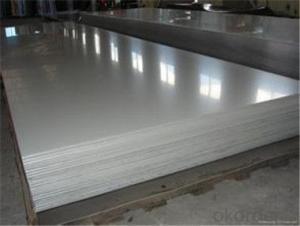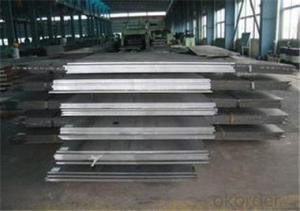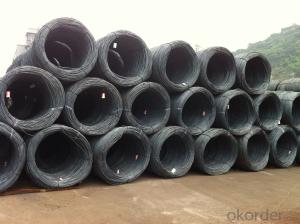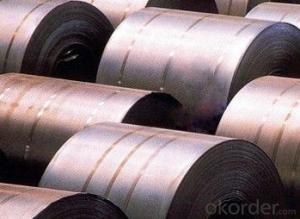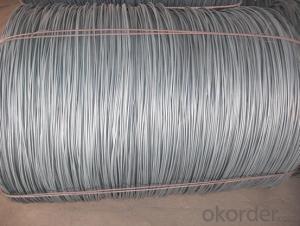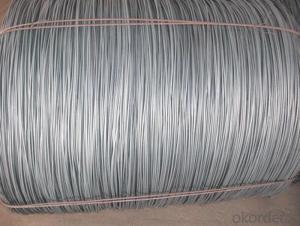Stainless Steel Sheet SS304 with Best Quality in China
- Loading Port:
- Tianjin
- Payment Terms:
- TT OR LC
- Min Order Qty:
- 50 m.t.
- Supply Capability:
- 45555555 m.t./month
OKorder Service Pledge
OKorder Financial Service
You Might Also Like
Item specifice
Description of stainless steel plate:
stanless steel sheet roll
Manufacturer since 2003;
Origin from Baosteel & Tisco;
100% Manufacture's direct deal.
Festures of stainless steel plate:
| Packaging Details: | standard packing to export 4 eye bands and 3 circumferential bands in steel, galvanized metal fluted rings on inner and outer edges, galvanized metal & waterproof paper wall protection disk, galvanized metal & waterproof paper around circumference |
| Delivery Detail: | 15-25 days after received your deposit or to your quantity |
Specifications of stainless steel plate:
Product Name | cr 1219x2438 stanless steel sheet 201 |
standared | JIS, AISI, ASTM, GB, DIN,SUS |
Thickness | 0.2mm~2.5mm |
Size | 1000*2000mm,1219*2438mm or as per customers' request |
Surface finish | 2B, BA, Hair Line, No.1,No.4, Mirror Finish |
Application | Kitchenware, decoration construction and building ornament, product parts manufacturing and stainless steel products tooling and so on |
Payment terms | T/T 30% for deposit, Balance against the copy of B/L; or L/C at sight |
Product Packing | wooden pallet |
Delivery time | within 15-20 working days after we got your 30% deposit |
Attention | FREE SAMPLES can be sent on request. We promise to provide our valued clients with high quality products, low price, and excellent client services. |
Images of stainless steel plate:
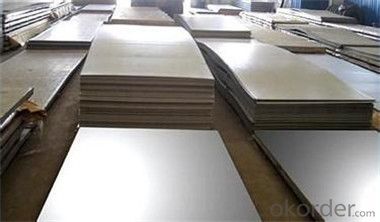
FAQ:
1. What is your package?
Packing situation: standard seaworthy packing or as customer required.
2. How long is the lead time?
Delivery time: 45 days after order confirmed.
3. What payment term do you accept?
Payment: T/T or L/C at sight.
- Q:What are the common production processes for americium-coated steel wire rod?
- The common production processes for americium-coated steel wire rod typically involve surface preparation, application of the americium coating, and post-treatment steps. The surface preparation includes cleaning and degreasing the steel wire rod to ensure proper adhesion of the coating. The americium coating is then applied using techniques like electroplating or physical vapor deposition. Finally, post-treatment steps such as annealing or heat treatment may be performed to enhance the coating's durability and functionality.
- Q:What are the common applications of high-strength steel wire rod?
- High-strength steel wire rods have a wide range of applications across various industries due to their exceptional strength and durability. Some of the common applications of high-strength steel wire rods include: 1. Automotive industry: High-strength steel wire rods are extensively used in the automotive industry for manufacturing various components such as springs, suspension systems, seat frames, and reinforcement bars. The high tensile strength of these wire rods ensures enhanced safety and stability in vehicles. 2. Construction industry: Steel wire rods find extensive use in the construction industry for reinforcement purposes. They are commonly used to strengthen concrete structures such as bridges, buildings, and highways. The high strength and ductility of these wire rods make them ideal for withstanding heavy loads and seismic forces. 3. Manufacturing industry: High-strength steel wire rods are widely used in the manufacturing industry for producing a variety of products, including cables, wire mesh, nails, screws, and fasteners. The superior strength and durability of these wire rods make them suitable for applications that require resistance to bending, twisting, and tension. 4. Aerospace industry: High-strength steel wire rods find applications in the aerospace industry for manufacturing aircraft components. They are used in the production of cables, control systems, landing gear, and engine components. The high strength-to-weight ratio of these wire rods plays a crucial role in ensuring the safety and reliability of aircraft structures. 5. Energy sector: Steel wire rods are commonly used in the energy sector for various applications. They are utilized in power transmission lines, suspension cables for bridges and power plants, and wire ropes for lifting heavy equipment. The high tensile strength and corrosion resistance of these wire rods make them suitable for withstanding the demanding conditions of the energy sector. 6. Consumer goods: High-strength steel wire rods are also used in the manufacturing of consumer goods such as furniture, appliances, and sporting equipment. They are employed in the production of springs for mattresses and chairs, wire frames for household appliances, and components for fitness equipment. The durability and reliability of these wire rods contribute to the longevity of consumer products. Overall, the common applications of high-strength steel wire rods span across industries, including automotive, construction, manufacturing, aerospace, energy, and consumer goods. Their exceptional strength, durability, and versatility make them a preferred choice for various applications where reliability and performance are crucial factors.
- Q:How is steel wire rod used in the manufacturing of automotive seat frames?
- Automotive seat frames commonly utilize steel wire rod for its superior strength and durability. By shaping the wire rod into various forms and sizes, manufacturers create sturdy frameworks that offer structural support and stability, capable of withstanding the weight and movements of passengers. To achieve the desired mechanical properties, the steel wire rod undergoes multiple manufacturing techniques, including hot rolling, cold drawing, and heat treatment. These processes ensure the wire rod possesses the necessary strength and flexibility required to endure the constant stress and load-bearing demands of automotive seat frames. Once prepared, the steel wire rod is bent and shaped using specialized machinery, enabling manufacturers to craft seat frame designs that meet specific requirements for different vehicle models. To create a robust and stable structure, the wire rod is often welded or joined together at specific points. The utilization of steel wire rod in automotive seat frames offers numerous advantages. Its high strength-to-weight ratio allows for supporting heavy loads without excessively increasing the vehicle's weight. Additionally, the steel wire rod exhibits excellent resistance to corrosion, ensuring the longevity and durability of seat frames, even in harsh environmental conditions. Furthermore, the use of steel wire rod provides flexibility in design and customization. Manufacturers can easily modify the shape and size of seat frames to accommodate various seat configurations and ergonomic needs, resulting in comfortable and safe seating options for passengers. In conclusion, the strength, durability, and customization capabilities of steel wire rod make it crucial in the manufacturing of automotive seat frames. It provides the necessary support and stability to ensure the safety and comfort of vehicle occupants.
- Q:How is the machinability of steel wire rod determined?
- The machinability of steel wire rod is determined through various factors and testing methods. One of the key factors is the composition of the steel, including the presence of alloying elements such as carbon, manganese, sulfur, phosphorus, and silicon. These elements can significantly affect the machinability of the steel. Another important factor is the microstructure of the steel, which is influenced by the manufacturing process, such as hot rolling or cold drawing. The microstructure determines the hardness, strength, and grain size of the steel, all of which can impact its machinability. To determine the machinability of steel wire rod, several testing methods are employed. One common method is the turning test, where a cutting tool is used to remove material from the wire rod while measuring various parameters such as cutting forces, tool wear, surface finish, and chip formation. These measurements can provide insights into the ease of machining the steel. Other tests may include drilling, milling, or tapping the wire rod to assess its machinability characteristics. These tests evaluate parameters such as tool life, cutting speed, feed rate, and surface roughness. The results of these tests help in determining the suitability of the steel wire rod for specific machining operations. Additionally, industry standards and guidelines, such as the American Iron and Steel Institute (AISI) recommendations, provide machinability ratings for different types of steel. These ratings are based on empirical data and can be used as a general guideline when selecting steel wire rod for machining applications. Overall, the machinability of steel wire rod is determined by a combination of factors including composition, microstructure, and various testing methods. By considering these factors, manufacturers and end-users can select the most suitable steel wire rod for their machining requirements.
- Q:What are the main factors affecting the hardness of steel wire rod?
- The main factors affecting the hardness of steel wire rod are the carbon content, the presence of alloying elements, the heat treatment process, and the mechanical working or deformation applied to the steel during production.
- Q:How is steel wire rod used in the production of wire mesh for sieving?
- Steel wire rod is a crucial component in the production of wire mesh for sieving. The wire rod is first processed through a series of manufacturing steps to transform it into a suitable material for wire mesh production. This includes drawing the rod through a die to reduce its diameter and increase its length, resulting in a thin and elongated wire. Once the wire rod has been transformed into wire, it is then woven or welded together to create wire mesh. Wire mesh is a grid-like structure with evenly spaced intersecting wires, forming a pattern of uniform openings. This mesh is designed to efficiently filter and separate particles based on their size. In the production of wire mesh for sieving, the steel wire rod is typically used to create the woven wire mesh. The wire is woven together using various weaving techniques, such as plain weave, twill weave, or Dutch weave, depending on the desired mesh characteristics. The wire rod's properties, such as its strength, flexibility, and resistance to corrosion, play a vital role in the quality and durability of the wire mesh. The wire rod's strength ensures that the wire mesh can withstand the tension and stress it may encounter during sieving operations. Additionally, the flexibility of the wire allows the mesh to be easily shaped and manipulated into various sizes and configurations to meet specific sieving requirements. Furthermore, the steel wire rod's resistance to corrosion prevents the wire mesh from deteriorating when exposed to moisture or harsh environmental conditions. This corrosion resistance is particularly important when wire mesh is used in applications where it comes into contact with liquids or substances that could potentially cause damage. Overall, the steel wire rod is an essential material in the production of wire mesh for sieving. Its transformation into wire and subsequent weaving or welding processes enable the creation of durable, reliable, and efficient wire mesh, which is widely used in various industries for sieving and separating particles of different sizes.
- Q:How is steel wire rod straightened and cut to length?
- Steel wire rod is straightened and cut to length using a combination of mechanical and automated processes. Firstly, the wire rod is passed through a series of straightening rolls that apply pressure to remove any bends or kinks, ensuring a straight and uniform shape. Once straightened, the rod is fed into a cutting machine equipped with circular blades or shears, which precisely cut it to the desired length. This process ensures that steel wire rod is efficiently straightened and cut to meet specific requirements in various industries.
- Q:What are the different types of steel wire rod coatings used for anti-corrosion properties?
- There are several types of steel wire rod coatings that are commonly used for their anti-corrosion properties. These coatings are applied to the surface of the steel wire rod to protect it from rust and corrosion in various environments. Some of the different types of steel wire rod coatings used for anti-corrosion properties include: 1. Zinc Coatings: Zinc coatings, such as galvanized coatings, are one of the most common types of coatings used for anti-corrosion purposes. These coatings provide a protective layer of zinc on the surface of the steel wire rod, which acts as a barrier against corrosion. Zinc coatings can be applied through hot-dip galvanizing or electroplating processes. 2. Aluminum Coatings: Aluminum coatings are another type of coating used for anti-corrosion properties. These coatings can be applied through processes such as hot-dip aluminizing or thermal spraying. Aluminum coatings provide a protective layer that prevents the steel wire rod from coming into contact with corrosive substances. 3. Epoxy Coatings: Epoxy coatings are a type of organic coating that is commonly used for anti-corrosion purposes. These coatings are applied as a liquid and then cured to form a hard and durable protective layer on the surface of the steel wire rod. Epoxy coatings provide excellent resistance against corrosion and can withstand exposure to harsh environments. 4. Polymer Coatings: Polymer coatings, such as polyethylene or polypropylene coatings, are often used for anti-corrosion properties. These coatings are typically applied through processes like extrusion or powder coating. Polymer coatings provide a protective layer that is resistant to chemicals, moisture, and other corrosive elements. 5. Ceramic Coatings: Ceramic coatings are known for their high resistance to corrosion and wear. These coatings are typically applied through thermal spraying or chemical vapor deposition processes. Ceramic coatings form a hard and dense layer on the surface of the steel wire rod, providing excellent protection against corrosion. It is important to choose the appropriate coating for a specific application based on factors such as the environment, operating conditions, and the level of corrosion resistance required. Each type of coating has its own advantages and limitations, so it is crucial to select the most suitable one to ensure long-term anti-corrosion protection for the steel wire rod.
- Q:How are steel wire rods used in the production of electrical cables for power transmission?
- Steel wire rods are indispensable in the production of electrical cables for power transmission. These rods are utilized to give the cables strength and support, ensuring their ability to endure the high voltage and mechanical strain associated with transmitting electricity over long distances. Typically crafted from high-quality carbon or alloy steel, the steel wire rods possess exceptional tensile strength and durability. These qualities make them suitable for withstanding the heavy loads and tension experienced by electrical cables during power transmission. Throughout the manufacturing process, the steel wire rods undergo wire drawing, which involves pulling them through a series of dies to reduce their diameter and increase their length. This procedure refines the steel's mechanical properties, enhances its uniformity, and allows for precise control over the wire's dimensions, guaranteeing compliance with the required specifications for power transmission cables. Once the wire rods are drawn to the desired size, they undergo further processing to create the individual strands that comprise the electrical cables. These strands are formed by twisting multiple steel wire rods together, resulting in a resilient and pliable core capable of carrying the electrical current. Following the formation of the strands, they are typically coated with insulation material such as PVC or XLPE. This insulation layer safeguards the steel wire rods from corrosion and provides electrical insulation, preventing any leakage or short-circuits during power transmission. In conclusion, steel wire rods play a vital role in the production of electrical cables for power transmission by providing the necessary strength and support to withstand the mechanical strain and high voltage involved in transmitting electricity over long distances. By incorporating steel wire rods into the cables, manufacturers can ensure the reliability and efficiency of power transmission systems.
- Q:How is steel wire rod used in the manufacturing of shelving systems?
- Steel wire rod is commonly used in the manufacturing of shelving systems due to its strength and durability. The wire rod is typically formed into various shapes and sizes to create the framework and support structure of the shelving system. Firstly, steel wire rod is often used to create the vertical posts or columns of the shelving system. These posts provide the main structural support and help to maintain the overall stability of the shelving unit. The wire rod is usually bent or shaped into a desired form, such as a rectangular or circular shape, to create these vertical posts. Additionally, steel wire rod is used to create the horizontal shelves or platforms of the shelving system. These shelves are typically made by welding or attaching the wire rods to the vertical posts at various intervals, creating multiple levels for storing items. The wire rod's strength ensures that the shelves can support heavy loads without bending or warping over time. Moreover, steel wire rod is often used to create the mesh or grid pattern that is commonly seen on shelving systems. This mesh design allows for improved air circulation and visibility of the stored items. The wire rods are woven or welded together to create a sturdy mesh pattern, ensuring that items placed on the shelves can be easily accessed and viewed. Overall, steel wire rod plays a crucial role in the manufacturing of shelving systems by providing the necessary strength, durability, and structural support. Its versatility allows for various designs and configurations, making it an ideal choice for creating functional and reliable shelving systems in a wide range of settings, including warehouses, retail stores, and homes.
1. Manufacturer Overview |
|
|---|---|
| Location | |
| Year Established | |
| Annual Output Value | |
| Main Markets | |
| Company Certifications | |
2. Manufacturer Certificates |
|
|---|---|
| a) Certification Name | |
| Range | |
| Reference | |
| Validity Period | |
3. Manufacturer Capability |
|
|---|---|
| a)Trade Capacity | |
| Nearest Port | |
| Export Percentage | |
| No.of Employees in Trade Department | |
| Language Spoken: | |
| b)Factory Information | |
| Factory Size: | |
| No. of Production Lines | |
| Contract Manufacturing | |
| Product Price Range | |
Send your message to us
Stainless Steel Sheet SS304 with Best Quality in China
- Loading Port:
- Tianjin
- Payment Terms:
- TT OR LC
- Min Order Qty:
- 50 m.t.
- Supply Capability:
- 45555555 m.t./month
OKorder Service Pledge
OKorder Financial Service
Similar products
New products
Hot products
Hot Searches
Related keywords
